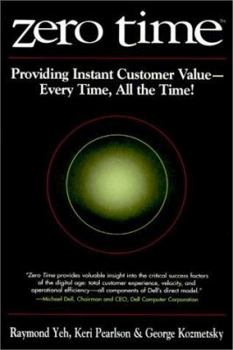Zero Time: Providing Instant Customer Value-Every Time, All the Time
Select Format
Select Condition 
Book Overview
In the superfast world of the 21st century, businesses must react instantaneously. Being a zero-time company involves more than compressing time - it's about providing value for every customer at every opportunity. To achieve this, firms must be willing to restructure and compress relationships: they must take advantage of all that the digital world has to offer. To put it simply, without the Internet, you can't be in zero time.
Format:Hardcover
Language:English
ISBN:0471382450
ISBN13:9780471382454
Release Date:July 2000
Publisher:Wiley
Length:288 Pages
Weight:1.25 lbs.
Dimensions:1.0" x 6.4" x 9.3"
Customer Reviews
2 ratings
Impressive Conceptual Meta-Model Built on Best Practices
Published by Thriftbooks.com User , 24 years ago
When the authors read The Discipline of Market Leaders, they must have immediately realized the potential of bringing the ideas of being an innovator, effective producer, and relationship manager together. This book fulfills that synthesis in a zero-time concept, of immediately providing value for stakeholders. In a December 1999 poll in Fast Company Magazine, 38 percent of respondents indicated that some aspect of their company already operated in a zero execution time mode. The book is built around five basic concepts for a targeted group of high profit margin customers:(1) Instant Value Alignment with customers (FedEx's commitment to on-time delivery and instant access to tracking information)(2) Instant Learning by employees and customers (Dell Computer's computer-based education at work cell assembly sites)(3) Instant Adaptation of the organization (G.E.'s focus on building a direction for the company around vision and trust)(4) Instant Execution of value for the customer (Progressive Insurance's accelerated claims processing methods)(5) Instant Involvement of all stakeholders (Cisco Systems' involvement with its suppliers and outsourcers from development through implementation for customers)A company can progress towards having all five elements in a three step process. First, you become a market leader by emphasizing either product/service innovation (employing instant learning and adaptation), operating excellence (using instant execution and involvement), or customer closeness (relationship building based on instant alignment and involvement). Second, you turn that into locking customers in by adding one more key element from the five part model. Third, you complete the transition into providing all five elements.A t-strategy is described for making this transition. You find an opportunity that is unfilled (such as the desire to be alone in the middle of other people that is partly served by the Sony Walkman), develop a key core competency for that conceptual space, and expand into some zero-time operations. You first apply that vision, core comptence, and distinctiveness for one market, then expand it into different, but similar (and usually related) markets. These market extensions form the vertical part of the 't' shape. For example, Dell Computer wants to employ direct selling with a competency of build-to-order to dominate the market for PCs by operational effectiveness. It expands from desk-top PCs to portable ones, then to servers, and now into storage. Now that you understand the model a bit, let me share a few quibbles. First, I disagree with the idea of focusing on a subset of customers who can provide the highest profit margin. I think a better concept is to identify the customers where they will give you the greatest combination of competitive insulation, profitability, and improvement in your economics of providing goods and services in order to be able to take on more customers profitably. Second, several
Insightful and provocative !
Published by Thriftbooks.com User , 24 years ago
The authors really take today's norm of 'operating companies' and challenges them to entirely re-think the fundamentals of their current operations for today and tomorrow. Zero Time is well thought out and raises the bar helping direct companies shift their paradigms in both thought and action to truly develop into tomorrow's champions - for the long term. It really is a must read for the new generation of e-business leaders and tomorrow's visionaries.





